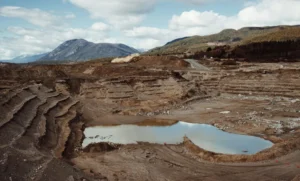Groundwater pollution is a silent issue that affects millions. Drinking water from what seems like a clean source, unaware that harmful chemicals and toxins are hiding beneath the surface.
This article shows how pollutants find their way into our groundwater, potentially risking our health and ecosystems. We’ll look into main causes, real-world examples, and potential solutions to protect this vital resource.
Ground Water Contamination
Groundwater pollution is a serious environmental issue that occurs when harmful substances seep into underground water sources. Once contaminated, groundwater can pose a big threat to human health and ecosystems, as it is usually used for drinking, irrigation, and industrial processes.
Here are the main reasons:
1. Agricultural Runoff
Farming is essential, but it comes with its challenges, especially in how it affects our water.
- Pesticides and Fertilizers: Chemicals used in farming seep into the soil, finally contaminating the groundwater below.
- Animal Waste: Waste from livestock can also find its way into underground water sources, bringing harmful bacteria and pathogens.
Example: In many rural areas, wells have been found with high levels of nitrates due to excessive fertilizer use.
2. Industrial Waste and Chemicals
Factories and industrial sites usually contribute to groundwater contamination.
- Toxic Spills: Industrial accidents or improper waste disposal can bring in harmful substances into the ground.
- Heavy Metals and Chemicals: These pollutants can stay in the water for years, affecting communities far beyond the industrial site.
In the 1980s, the town of Woburn, Massachusetts, became infamous for a bunch of leukemia cases traced back to chemical dumping that polluted the groundwater.
3. Leaking Septic Systems
Septic systems that are not properly maintained can leak contaminants into the ground.
- Household Waste: Wastewater from homes can carry pathogens, nitrogen, and phosphates, all of which can compromise groundwater quality.
- Improper Drainage: Poorly designed septic systems or those built-in unsuitable locations can cause leakage.
4. Urbanization and Landfills
As cities grow, more waste is produced, and improper waste management becomes a major issue.
- Landfill Runoff: When rainwater passes through landfills, it picks up chemicals from waste and can contaminate the groundwater.
- Urban Runoff: Oil, heavy metals, and other pollutants from roads and buildings are washed into the ground during storms.
5. Natural Sources of Contamination
Not all groundwater pollution is caused by humans.
- Arsenic and Radon: These naturally occurring elements can sometimes be found in groundwater, particularly in areas with specific geological formations.
- Salinity: Coastal areas may face issues with saltwater intrusion, where seawater enters freshwater aquifers.
Conclusion
Groundwater pollution is a serious problem caused by various factors. These include agricultural activities, industrial waste, septic system leaks, urbanization, and natural sources.
To protect this vital resource, it’s essential to implement measures such as improved farming practices, stricter regulations for industries, proper septic system maintenance, sustainable urban planning, and careful monitoring of natural contaminants.
FAQ's
How does groundwater get polluted?
Groundwater pollution is mostly caused by agricultural runoff, industrial waste, septic system leaks, urbanization, and natural sources.
What is the primary threat to groundwater?
The primary threat to groundwater is contamination from various pollutants, including chemicals, bacteria, and heavy metals.
Can you clean up groundwater pollution?
While it’s challenging to completely clean up groundwater pollution, various methods can help lessen its effects, such as source control, treatment technologies, and groundwater monitoring.
How does water get polluted?
Water can get polluted through various sources, including surface runoff, industrial discharges, agricultural activities, and wastewater treatment plant leaks.




